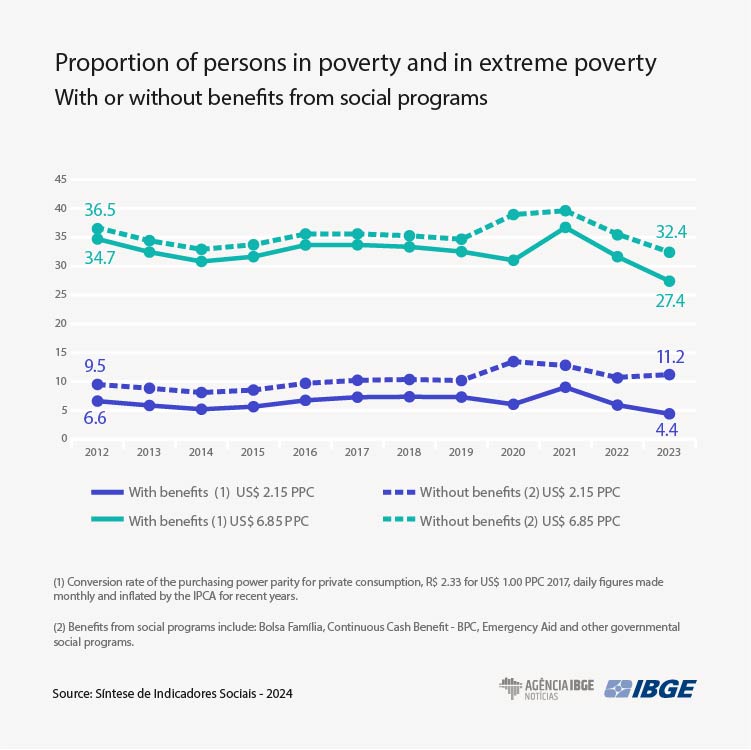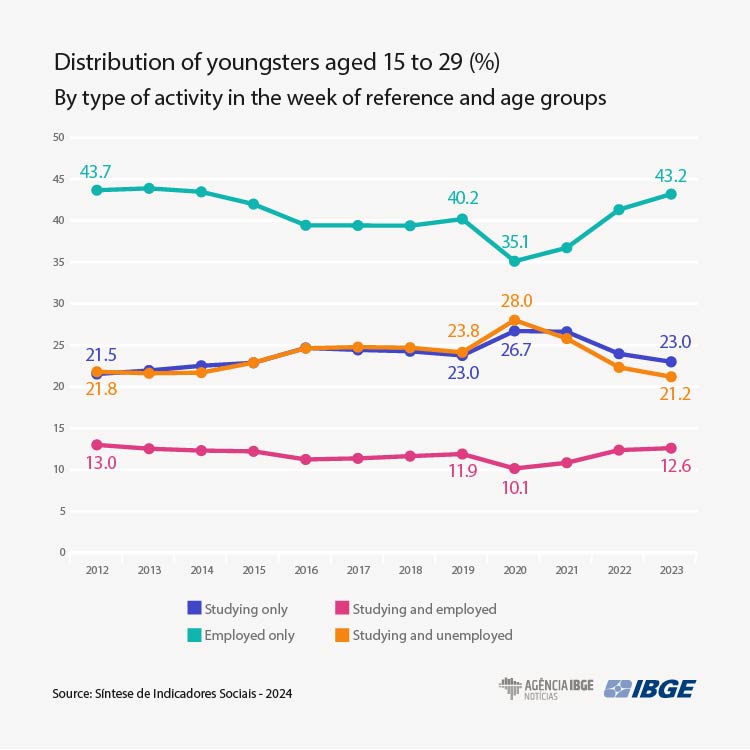Summary of Social Indicators
In 2023, poverty in the country drops to lowest level since 2012
December 04, 2024 10h00 AM | Last Updated: December 09, 2024 09h35 PM
Highlights
- From 2022 to 2023, the percentage of the population in the country living below poverty line of the World Bank (US$ 6.85 PPC a day or R$ 665 a month) fell from 31.6% to 27.4%. This is the lowest figure since 2012.
- In one year, 8.7 million persons escaped poverty in the country. In numerical terms, this population fell from 67.7 million to 59.0 million, its lowest figure since 201
- In the same period, the proportion of the population in extreme poverty (US$ 2,15 PPC a day or R$ 209 a month decreased from 5.9% to 4.4%, the lowest percentage since 2012. For the first time, this indicator is below 5.0%.
- From 2022 to 2023, approximately 3.1 million persons escaped extreme poverty, in the country. The population in extreme poverty dropped from 12.6 million to 9.5 million, the lowest figure since 2012.
- In 2023, about 51% of the persons living in rural areas were residents of housing units who were granted social benefits. In urban areas, the proportion was 24.5%.
- Among persons aged 0 to 14, 42.7% (or two out of five) living housing units that received social benefits.
- In 2023, the total number of youngsters aged 15 to 29 who were neither studying nor working reached its lowest level (10.3 million) and lowest proportion (21.2%) since the start of the series, in 2012.
- Among 10.3 million youngsters aged 15 to 29 who were neither studying nor working, there were 4.6 million black or brown women (or 45.2% of this total, whereas white women were 1.9 million (or 18.9%). Black or brown men were 2.4 million (23.4%) and white men, 1.2 million (11.3%).
- Income per hour of white workers (R$ 23.02) made up 67.7% being higher than that of black or brown workers (R$13.73).
- In 2023, average income per hour worked by men (R$18.81) exceeded that of women (R$16.70) by 12,6%. The biggest inequality was found among persons with a higher education degree, with men having higher income (R$42.60) than women (R$30.03), 41.9% higher.

From 2022 to 2023, the percentage of the population with per capita household income below the poverty line of the World Bank (US$ 6.85 PPC a day or R$ 665 a month) fell from 31.6% to 27.4%. That was the lowest proportion since 2012. In numerical terms, this population decreased from 67.7 million to 59.0 million, its lowest figure since 2012. In one year, 8.7 million persons in the country escaped poverty. Data come from the Summary of Social Indicators (SIS) 2024, released today by the IBGE. Read also news on education and health and new geographic divisions.
In the same period, the proportion of the country’s population with per capita household income below the World Bank extreme poverty line (US$ 2.15 PPC a day or R$ 209 a month) fell from 5.9% to 4.4%, the lowest proportion since 2012. For the first time, this indicator stood below 5.0%. In Absolute figures, the population in extreme poverty dropped from 12.6 million to 9.5 million persons, also the lowest result since 2012. In one year, about 3.1 million persons escaped extreme poverty.
In this analysis, the IBGE considered the World Bank lines according to the Purchasing Parity Power (PPC), which monitor SDG 1 (Eradicate extreme poverty).
Considering the non-existence of social programs implemented by the federal government, the proportion of persons in extreme poverty in 2023 would have increased from 4.4% to 11.2%. The proportion of the population in poverty would have increased from 27.4% to 32.4%.

Social programs prevent increase of income inequality in 2023
In 2023, the Gini index (0.518) kept the same level as in 2022, indicating there has been no drop in income inequality from the previous year. André Simões, a member of the SIS team, states that “as they affect the income basis more often, social benefits prevent the rise of the Gini index, since, without these benefits, the Gini index would have changed from 0.518 to 0.555.
In Brazil, in 2023, the total income of the 10% with the highest income was 3.6 times higher than the income of the 40% with the lowest income. There was no change from 2022, in line with the results of Gini index.
Employment reduces the incidence of poverty in 2023
Among employed persons, less than 1% were considered extremely poor in 2023, whereas among the unemployed that proportion reached 14.6%. Likewise, the proportion of poor employed persons (14.2%) was significantly lower than that of poor unemployed ones (54.9%).
According to André Simões, “these indicators show there is poverty in the employed population, probably related to social vulnerability in some segments of the labor market. However, poverty and extreme poverty among workers are lower than in the unemployed population.”
More than half of the rural population lives in households benefited by social programs
From 2022 to 2023, the proportion of persons living in households benefited by social programs increased from 25.8% to 27.9%. In 2020, peak of the series, this proportion had reached 36.8%, due to benefits granted by the government to minimize the effects of the COVID-19 pandemic.
In 2023, about 51% of the persons living in rural areas lived in housing units benefited by social programs. In urban areas, this proportion was 24.5%. Among persons aged 0 to 14, 42.7% lived in housing units benefited by social programs. This proportion decreases with age, and reaches 14.7% among persons aged 6- and over. That is, social programs are present in the lives of two out of every five children in the country.
Number of youngsters who do not study or work is the lowest since 2012
In 2023, the total number of youngsters aged 15 to 29 who were neither studying nor employed was the lowest (10.3 million) and had the lowest rate (21.2%) since the start of the series, in 2012. Denise Guichard, analyst at the IBGE, explains that “this reduction is due to the improvement of labor markets, increase in the number of youngsters who were studying and employed and also to demographic changes that lead to a gradual reduction of the younger population in the country.”
The lower the income range, the bigger the proportion of youngsters aged 15 to 29 out of the system and unemployed. In 2023, about 21.2% of the youngsters were neither studying nor working. However, among the 10% of households with the highest income, 6.6% of the youngsters were in this condition, whereas in 10% of the households with the lowest income, 49.3% of the youngsters (almost half) were neither studying nor working.

Black or brown women represent 45.2% of the youngsters that neither work nor study
Among the 10.3 million youngsters aged 15 to 29 who were neither studying nor employed in Brazil in 2023, gender and color or race inequalities remained: black or brown women were 4.6 million (or 45.2% of the total of youngsters who were neither studying or working), whereas white women were 1.9 million (or 18.9%). Black or brown men were 2.4 million (23.4%) and white men, 1.2 million (11.3%).
The number of youngsters who were neither studying nor working dropped by 4.9% between 2022 and 2023. However, the main drops in the period were among white women (11.9%) and among black or brown men (9.3%). For white men the decrease was lower (6.5%) and black or brown women recorded the smallest decrease in the period (1.6%).
Proportion of women out of school and of labor force surpasses that of men
The indicator of youngsters aged 15 to 29 who were neither studying or employed includes, simultaneously, those who were not studying but were searching for work (unemployed youngsters) and those who were not studying or searching for work (youngsters out of the labor force).
In 2023, among young women who were neither studying nor employed, 76.5% were out of the workforce, whereas the proportion among men was 61.7%, a difference of 14.8 percentage points. For Denise Guichard, “It evidences household chores and care for relatives make it more difficult for women to find a position in the labor market.”
Labor market improves, but inequalities remain
The total number of persons employed in 2023 reached its peak since 2012: 100.7 million, with an increase of 3.7 million persons (or 3.8%) from 2022. This increase was observed among workers with a formal contract (2.0 million) and without a formal contract (1.7 million).
In 2023, the employment population ratio for the population overall was 57.6%. for men, this indicator reached 67.9%, against 47.9% for women, a difference of 20 percentage points which, except small oscillations, has been almost the same since 2012.
Income per hour of white workers is 67.7% bigger than that of black or brown persons
The investigation of inequality of income becomes more detailed when the number of hours worked is considered. Income per hour of white workers (R$ 23.02) was 67.7% higher than that of black or brown ones (R$13.73). Inequality remained in all the levels of schooling, being higher (43.2%) in the employed population with a higher education degree: R$ 40.20 for white persons against R$ 28.10 for black or brown ones.
In 2023, income per hour of men (R$18.81) surpassed that of women (R$16.70) by 12.6%. As in the comparison by color or race, the biggest inequality was observed among persons with a higher education degree, with the average income of men (R$42.60) surpassing that of women (R$30.03) by 41.9%.
Informal work and underutilization of workforce also show inequalities
From 2022 to 2023, the proportion of persons with informal occupations in the total number of workers in the country changed from 40.9% to 40.7%, which indicates stability. The informality rate reached 45.8% among black or brown employed persons, versus 34.3% among white persons. These results reflects historical inequalities.
Similar inequalities are found in relation to the compound underutilization rate of labor force, which consists of unemployment, time-related underemployment and potential workforce. This indicator reached 20.9% in 2022, with a drop to 18.0% in 2023. However, for men, underutilization hit 14.4%, whereas for women the rate hit 22.4%. For white persons, underutilization rate was 13.5%, and for black or brown ones hit 21.3%.
More about the survey
The Summary of Social Indicators: ana analysis of the Brazilian population’s living conditions 2024, systematizes information about local reality and the living conditions of the Brazilian population.
The study presents indicators for 2012 to 2024 about economic structure and labor market; standard of living and income distribution (including poverty lines), housing conditions; education and health conditions. Geographies include Major Regions, Federation Units and, for some indicators, municipalities of capitals.
In this edition, new analyses are presented, such as indicators on living conditions by geographic strata; housing conditions by status of monetary poverty; among others.




















